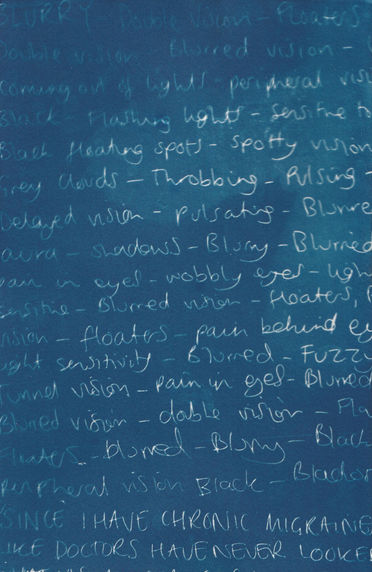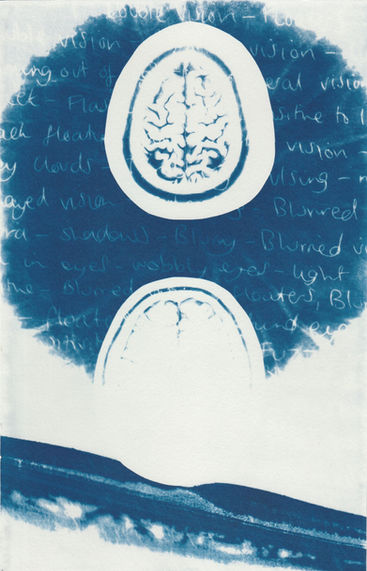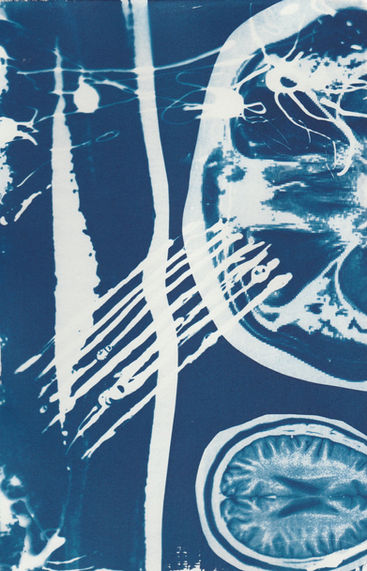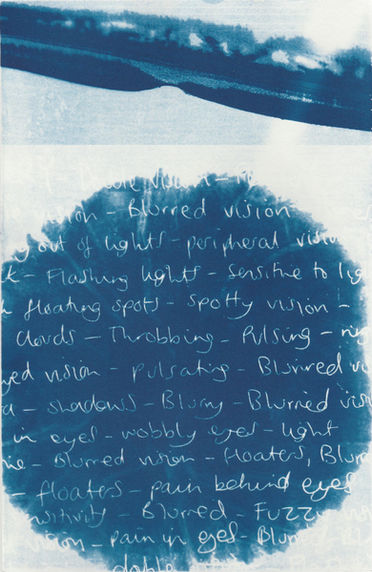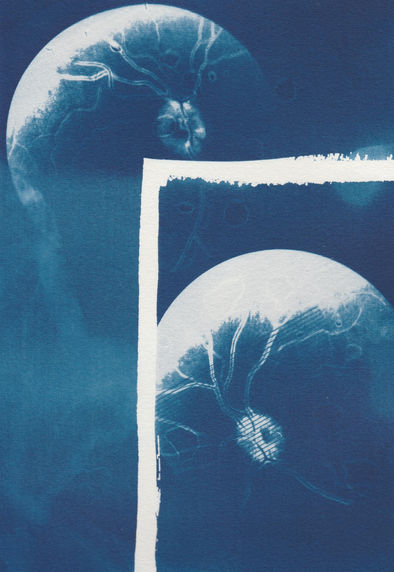
PREDICTING PAPILLOEDEMA
Predicting papilloedema is a project focused on an invisible symptom of Idiopathic Intracranial Hypertension (IIH), papilloedema (optic nerve swelling). IIH is a rare brain condition with no known cause or cure which affects predominantly women ages 25-35. Papilloedema is the symptom that leads to a diagnosis of IIH and can be picked up by a high street optician.
In collaboration with the POP study group from the University of Birmingham, Mellissa worked closely with mathematician Dr. Leandro Junges, Neurologist & Ophthalmologist Professor Susan Mollen & Professor Alex Sinclair who are leading research for IIH working with artificial intelligence (AI) in technology to find less invasive procedures to diagnose this invisible condition.


Map of IIH Symptoms Digital illustration & Digital Negative, 2020
IDIOPATHIC INTRACRANIAL HYPERTENSION (IIH)
IIH is a rare brain condition that increases the amount of CSF fluid (spinal fluid) produced in the spinal cord. The symptoms include papilloedema (optic nerve swelling), pulsatile tinnitus, disabling migraines, and severe spine/back pain, in some cases it can cause partial or completes. These symptoms are mimicking a brain tumor and the cause of IIH is unknown, predominantly affecting women between 25-35 but also affecting men and children. There is currently no cure and scientists Professor Alex Sinclair & Dr. Susan Mollen from the University of Birmingham are working on effective treatment as well as working with NASA as astronauts develop IIH after space travel.
Since being diagnosed in 2018 I spent a year feeling isolated and depressed as a lot of GPs don't know what IIH is. Until I found the IIH UK community with hundreds of other women with common stories of medical professionals disregarding their symptoms because of obesity being one of the possible causes of IIH. Other possible causes, hormone imbalance, medications such as antibiotics, steroids and the contraceptive pill, iron deficiency, chronic kidney disease or lupus.
There is a stigma attached to the condition as it occurs frequently in overweight women and obesity it highlighted in society, media and news as a national health emergency. In turn this adds pressure to healthcare professionals to focus on. the visible side affects in can be discriminating and offensive to those that are overweight. Eventually, I found IIHUK who helped me to understand my IIH and how it affects my body.


SMQB Systems Modeling and Quantitive Biomedicine: Artist in residence March 2020 - April 2021
Meeting collaborators at the seedcorn event (February 2020) for SMQB's artist in residence groups for the first time to plan our projects and research for the 6 month residency completely changed a few weeks later when the pandemic hit the UK. With lockdown and the majority of the group deployed to work on covid wards, changing an extremely hands-on residency to remote and digital experimentation pulled my practice into new areas of inquiry.
The residency was extended by numerous lockdowns in the UK with the hope of a final exhibition but instead decided to create a virtual exhibition and online webinar event to showcase how artists had navigated through the residency. Collaborating remotely was a new venture for all artists and navigating a different way of working whilst having limitations of services, led my experimental process towards working with materials I had at home. The research was developing algorithms to provide clinicians assistive technology within OCT machines (optical coherence technology) these machines use lightwaves to create an image of the back of the eye. With this in mind, I decided to explore making images with the alternative photography process, Cyanotype. This is where you mix ferric ammonium citrate and potassium ferricyanide together and paint onto paper to create light-sensitive paper, which you can block out with objects or digital negatives. Throughout various lockdowns, I explored this process, along with the toning process to create a series of cyanotype prints in collaboration with the IIHUK community.
BLUEPRINT OF PAPILLOEDEMA
These prints were made through lockdown 2020 and part of SMQB (Systems Modeling and Quantitative Biomedicine) at the University of Birmingham. Monsoon worked in collaboration with the IIHUK Charity community who shared descriptions of their symptoms for papilloedema (optic nerve swelling). These descriptions were translated into visual art by using the cyanotype process to mimic the process of an OCT (optical coherence technology) machine which is used in opticians and hospitals to take images using lightwaves of the back of the eye.
Blog posts throughout the residency can be read here.
VIRTUAL EXHIBITION


